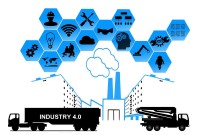- Home
- Business Processes
- Industry Knowledge
- Aerospace Industry
- Automotive Industry
- Banking Domain
- BFSI Industry
- Consumer/ FMCG Industry
- Chemicals Industry
- Engineering & Construction
- Energy Industry
- Education Domain
- Finance Domain
- Hospitality Domain
- Healthcare Industry
- Insurance Domain
- Retail Industry
- Travel and Tourism Domain
- Telecom Industry
- Leadership Skills
- eLearning
- Home
- Business Processes
- Order to Cash
- Warehouse Labeling Process
Warehouse Labeling Process
Warehouses can be places where piles of packed or loose products occupy space. If left disorganized, it will become very challenging to identify products for packing or picking. Hence, proper organization of warehouse is very important. Warehouse labeling systems eliminate this problem by making sure products are easily identified and managed during the warehousing and shipping process. Labeling is the most functional and cost-effective way to keep your warehouse organized and operating efficiently.
What are warehouse labels?
Labels are printed slips that are affixed to warehouse goods for identification or description. Important information about the package or the item is prominently displayed on the label. Label is the written or printed matter accompanying an article to furnish identification or other information.
Why we need labeling system in place?
Warehouses can be places where piles of packed or loose products occupy space. If left disorganized, it will become very challenging to identify products for packing or picking. Hence, proper organization of warehouse is very important. Warehouse labeling systems eliminate this problem by making sure products are easily identified and managed during the warehousing and shipping process. Labeling is the most functional and cost-effective way to keep your warehouse organized and operating efficiently.
Here are some of the advantages of warehouse labeling.
• Warehouse labels eliminate mistakes.
• Ensures customers only receive the item they ordered.
• Provide warnings for items that should be treated with care.
• Capture several data elements like expiration dates, security or caution notes.
• Eliminated the confusion around location of items.
• Improve the efficiency and productivity of employees.
• Prevent supply chain issues such as backorders or incorrect shipments.
Types of Warehouse Labels
Depending on your business’s warehousing needs, there are several types of warehouse labels to choose from. Each of these items can be used together to streamline warehouse organization and make sure workers can easily identify every section, rack, and carton. Most warehouse labels are easy to install, which makes the labelling process quick and efficient. Availability of variety of label options can address the unique needs of manufacturing and warehousing companies.
Given below are some of the most common types labels:
Floor Labels
Floor labels are ideal for large warehouses with several rooms. They are manufactured to survive heavy floor traffic and wear and tear. They are designed to withstand harsh solvent, oil, hydrocarbon solutions, and other contaminants, and they can be customized for any size, shape, length, or content requirements.
Rack Labels
The most common type of warehouse label is a rack label, which is used to streamline workflow by making items and sections easier to identify for employees. They help identify the right products for inventory management, storing, and shipping purposes. There are several types of rack labels, and they include multi-level, magnetic, cold storage, and more. Rack labels can be easily color-coded for identification; they can also be designed with arrows, and can be placed on aisles for easy locating of items.
Warehouse Magnets
Out of all the warehouse label options, magnets are the most reusable option. They can be applied regardless of temperature, removed without any mess or scratches, and can be reapplied without the need of sticky adhesives like tape. Magnetic signs and labels are typically used for shelf and rack location labeling as they can be moved when required.
Retro-Reflective Labels
This option is used for barcoding shelves. They can be scanned up to 45 feet away due to use of light reflecting elements in the label. They are a great solution for warehouse racks, pallets, and other industrial surfaces.
Warehouse Signs
Warehouse signs can help identify hazards to employees working in the plant. Since most warehouse workers operate heavy machinery and have to navigate around sharp corners and aisles, warehouse signs are extremely important. Employees should be made aware of proper procedures and potential hazards within the warehouse, and these safety signs are helpful for notifying workers of forklift safety warnings, clearance height and capacity alerts, quality-control warnings, and safety reminders.
Related Links
You May Also Like
-
At a high level, the essential elements in a warehouse are an arrival bay, a storage area, a departure bay, a material handling system and an information management system. As part of the process for enabling a warehouse layout, you must define warehouse zone groups, and zones, location types, and locations.
-
Types of Order Picking Methods in the Warehouse
There are many different types of picking in a warehouse and each one works as a customized solution for each business. Depending on the size of your warehouse and inventory, the manpower you have on hand, and the number of customer orders made each day, there may be certain methods that are more efficient for you than others.
-
Business Case of Multiple Warehouses
Adding extra warehouses to business provides many benefits such as reducing shipping costs, increasing storage capacity, and having warehouses for specific purposes to simplify overall warehouse management. Multiple warehouses allow you to organize your inventory in a way that helps your business be more effective.
-
After products have been received and passed a quality inspection, they need to be stored so that you can find them when you need them. This process is called putaway. The spot where you store a particular product is called a location. One section of a warehouse might have small locations for light items; another area may have large locations on the floor for heavy items.
-
What is the difference between Warehouse Management & Inventory Management?
The terms “inventory management” and “warehouse management” are sometimes mistakenly used interchangeably as they both deal with operations and products of industries. Despite their few similarities, there are many notable differences between warehouse and inventory management systems.
-
In the normal course of business, customers are likely to return orders from time to time due to various reasons and business should design processes the manage and accept such returns. A well designed returns management process can reduce costs and issues associated with returns or exchanges.
-
Warehouse management and distribution logistics involve the physical warehouse where products are stored, as well as the receipt and movement of goods takes place. Warehouse management aims to control the storage and movement of products and materials within a warehouse. These operations include the receipting of inwards goods, tracking, stacking and stock movement through the warehouse.
-
The Outbound process starts with routing the shipments. The Outbound execution process starts from the point when pick tasks are completed for an outbound shipment and ends at the point where the outbound packages are loaded into trailers. The Warehouse Outbound process includes managing and controlling outgoing materials starting from the download of orders through to the shipping of products from the warehouse.
-
Overview of Warehouse Processes
The basic function of a warehouse is to store goods. This means that they receive deliveries from suppliers, do any necessary checking and sorting, store the materials until it is dispatched to customers. Traditionally warehouses were seen as places for the long-term storage of goods. Now organizations want to optimize their customer experience and try to move materials quickly through the supply chain, so the role of warehousing has changed.
-
Transport operations are often divided into full load and part load and due to economies of scale, the unit costs are higher for part loads. Our customer needs several part loads delivering, so it can reduce costs by consolidating these into full loads. Then it gets all the part loads delivered to a warehouse near the suppliers, consolidates them into full loads, and pays the lower costs of full-load transport to its operations.
Explore Our Free Training Articles or
Sign Up to Start With Our eLearning Courses

About Us
Learning
© 2023 TechnoFunc, All Rights Reserved











